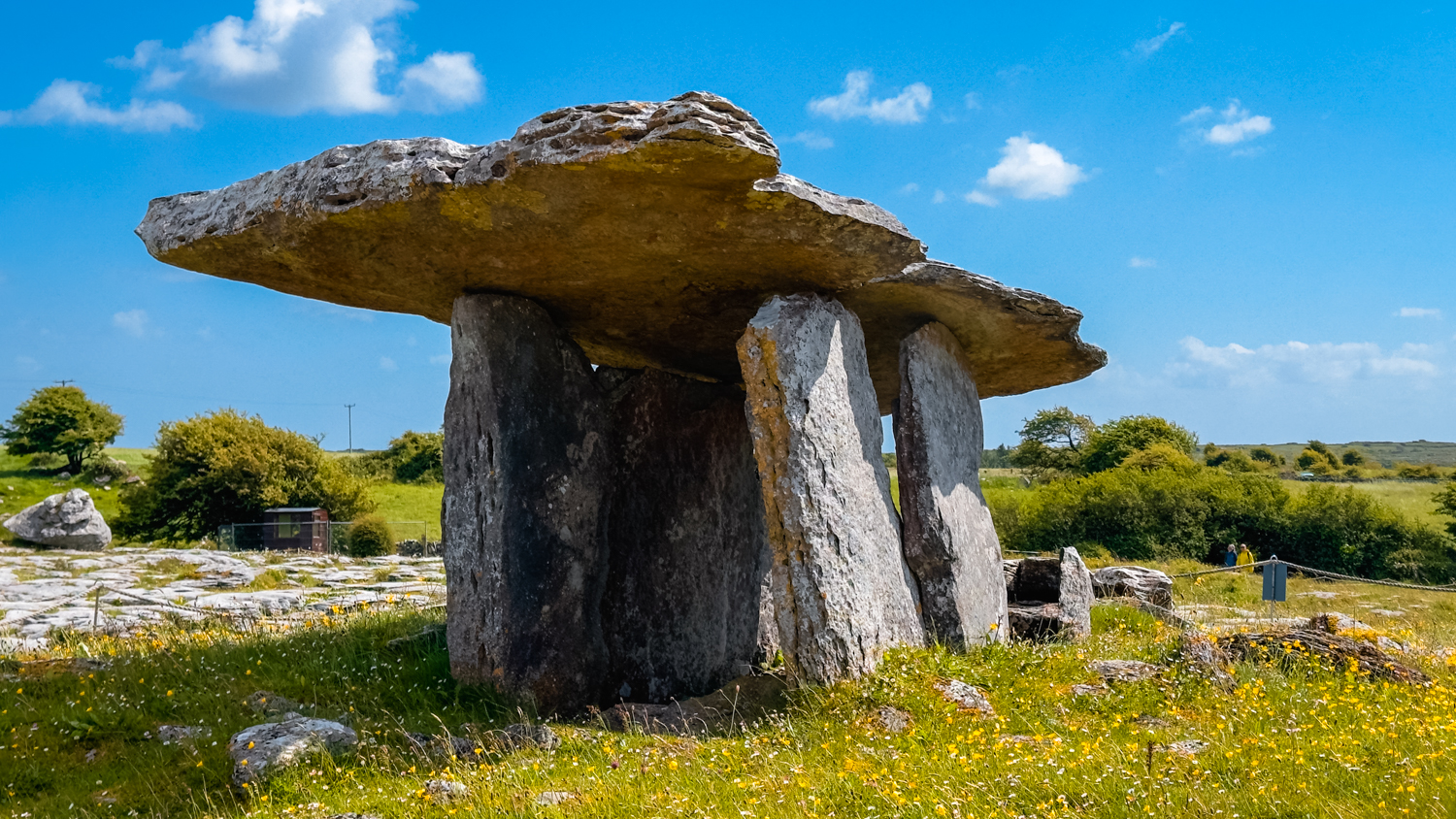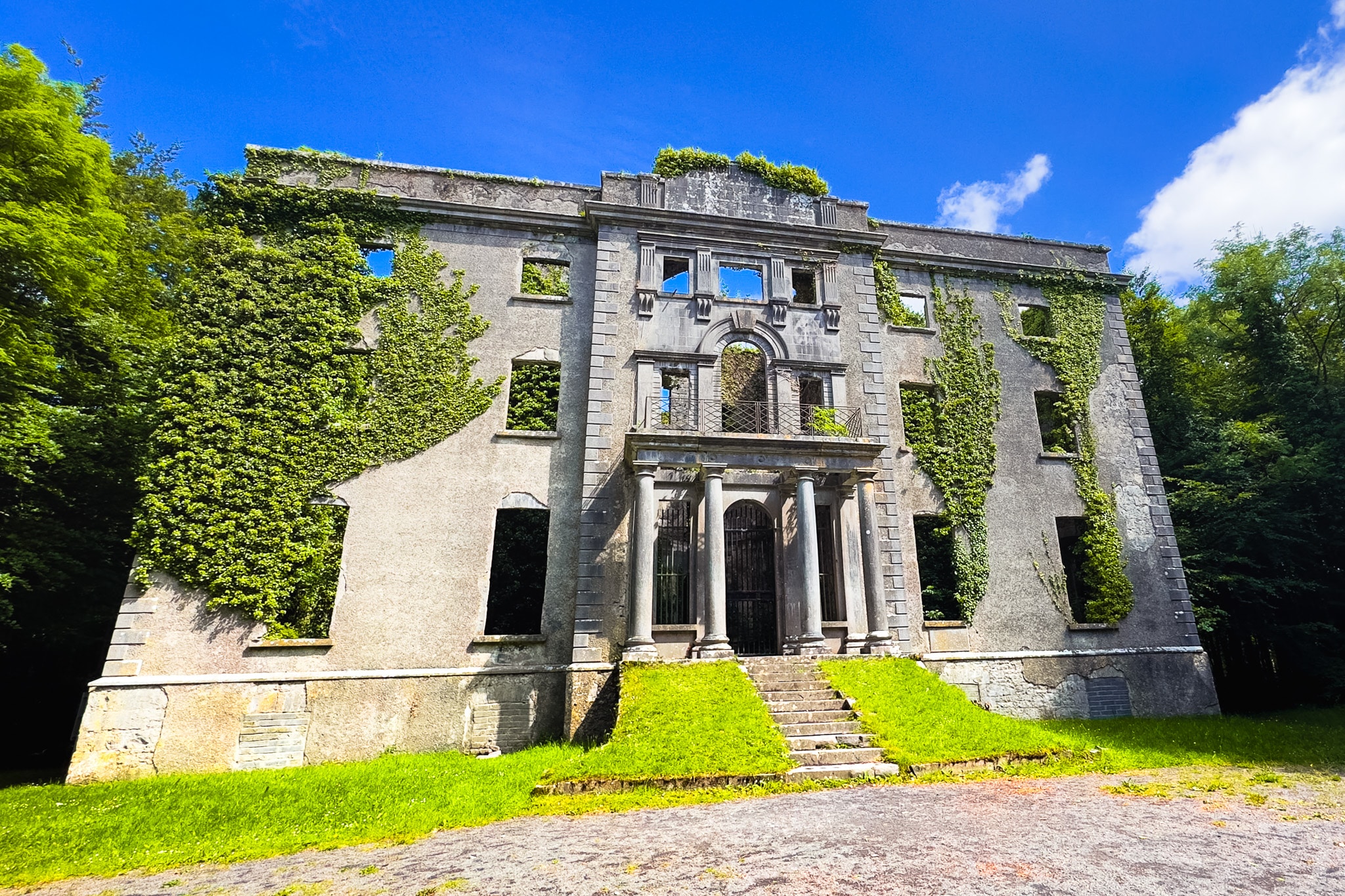Poulnabrone Dolmen, Ireland’s 5,000-Year-Old Portal Tomb

Hidden in the rugged, rocky landscape of the Burren, Poulnabrone Dolmen is one of Ireland’s most famous archaeological sites. If you’re road-tripping through County Clare, it’s a must-see. This 5,000-year-old portal tomb has been standing strong for millennia and is an incredible look into Ireland’s ancient past.
Built sometime between 4200 BC and 2900 BC, Poulnabrone Dolmen was used as a burial site for over 600 years! When archaeologists excavated it, they found the remains of at least 33 people, along with stone tools, pottery, and other artifacts. Today, it’s one of the most photographed megalithic tombs in the country and I get why. It’s really cool!
There are 172 portal tombs across Ireland, but this one is the oldest and best-preserved. It’s also the second most-visited site in the Burren, right after the Cliffs of Moher. Even with the crowds, it still has this quiet, otherworldly presence—standing alone against the rugged limestone landscape like something straight out of a fantasy novel.
The first time we heard portal tomb, we thought of a Star Trek-style teleportation device (and we weren’t the only ones—there were even some fans cosplaying like they’d just stepped through a wormhole). But nope, the name comes from its design, not its ability to zap you across dimensions.
The vertical portal stones hold up a massive capstone, giving it that distinct, ancient look. That said, if anywhere in Ireland did have time-travel potential, this would be it.
If you love history, archaeology, or just standing in places that feel like they’ve been frozen in time, Poulnabrone Dolmen is absolutely worth a stop!
History of Poulnabrone Dolmen
The Poulnabrone Dolmen is an important Irish cultural heritage site and this monumental stone structure has captivated people for over 5,000 years.
The name “Poulnabrone” comes from the Irish “Poll na Brón” which means “Hole of the Quernstone” and is sometimes translated to “Hole of Sorrows”. Dolmen means “stone table” or “large stones” and often refers to portal tombs.
Since Poulnabrone Dolmen is estimated to have been built between 4200 BC and 2900 BC, its exact origins and uses aren’t totally clear. Even though it, and portal tombs in general, aren’t fully understood, all it takes is one look at the imposing stones to see why it’s thought to have spiritual significance.
It was once covered with earth and topped with a cairn and would have been visible for miles around. It’s thought to have been a burial and ritual site, as well as a territorial marker.
Archaeological Discoveries at Poulnabrone Dolmen
Even though Poulnabrone Dolmen is the oldest and best-preserved portal tomb in Ireland, it wasn’t studied until 1986 when one of the structural rocks looked ready to collapse and they replaced it (the original stone is still on-site and is just behind the tomb).
The excavations, lead by Ann Lynch — who talks about this in the above video — uncovered the remains of over 33 people in the limestone pavement cracks (called grikes) in the tomb’s main chamber. However, it’s thought that the people were originally buried elsewhere and moved here.
Alongside the skeletal evidence, numerous artifacts such as pottery, tools, and personal ornaments such as beads and pines were discovered. These artifacts are in the Clare Museum in Ennis, on loan from the National Museum of Ireland.
In addition to being Ireland’s oldest and best preserved portal tomb, Poulnabrone Dolmen is the second largest in Ireland, next to Brownshill Dolmen in County Carlow.
Visiting Poulnabrone: Tips & Guidelines
You absolutely don’t want to miss exploring the mysteries and marvels of ancient Ireland at Poulnabrone Dolmen. Ireland is home to lots of history (and a few hidden gems!), but few sites are as old as this portal tomb.
Nestled in the stark yet beautiful Burren landscape of County Clare, this megalithic tomb offers a unique glimpse into stone age Ireland and the rich cultural heritage that defines the Emerald Isle.
Before you set off on your historical tour, here’s some advice to ensure you have an enjoyable and respectful visit.
- Visit in the off season: For fewer crowds and a more intimate connection with the ancient site, visit during the quieter months of spring or autumn. Tour buses do come here and it can become very busy in the main tourist season.
- Expect the unexpected: The Irish weather is notorious for its unpredictability, so come prepared for all conditions. Dressing in layers and bringing waterproof gear will keep you comfortable while exploring the portal tomb and other historical sites.
- Respect the past: Remember, Poulnabrone Dolmen is not just a tourist attraction but a sacred burial site. Be mindful of your surroundings, avoid climbing on the stones, don’t trample the delicate flowers and plants, and leave no trace behind to preserve this piece of Irish history for generations to come.
Tours to Poulnabrone Dolmen
What to Expect: Parking, Fees & Site Details
Poulnabrone Dolmen is located roughly halfway between Galway (54 km) and Limerick (66 km). The most convenient ways to visit are to rent a car, take a tour, or use a taxi/ride share.
Located on R480, the road to the parking lot is paved, but — just like most Irish country roads — it’s quite narrow. There’s lots to see along this road and nearby, including Cahermore Fort, Bhail Albóin, Newtown Castle, Gleninsheen Wedge Tomb, Cathair Chonaill, Carron Church, and Leamenah Castle.
- Parking: There’s a large, free parking lot at the entrance to the trail.
- Fee: There’s no cost to visit Poulnabrone Dolmen.
- Trail: The trail from the parking lot is well-marked and obvious. There are educational signs about the tomb and landscape in Irish and English along the way.
Find a car rental
Poulnabrone Dolmen Trail & Site
The gravel pathway from the parking lot to Poulnabrone Dolmen is flat and pretty short. It doesn’t take long to reach the tomb.
Along the way, you’ll encounter educational signs where you can read up on the history of the area — definitely take time to read these, they’ll give you a lot more insight on the area and greater appreciation.
The portal tomb itself is roped off, but you can walk up onto the limestone pavement to get a good look at it from all angles; take care to not damage the pavement which is protected by the EU Habitats Directive.
When you reach Poulnabrone Dolmen, don’t just snap a few photos and leave. Take some time to truly appreciate what you’re viewing — there’s over 5,000 years of history here! From the people who built it (how did they move the huge stones into place?) to the people who were buried here to the visitors who have visited over the years, there’s a lot of history here.
Once you’ve checked out the tomb, take some time to wander among the limestone and unique flora. It’s fascinating to explore the rock that looks like it’s been intentionally carved.
Geographical Setting in the Burren
When you visit County Clare, you’ll immediately know when you’ve reached the Burren. It’s unmistakable. This vast, ancient terrain is speckled with limestone pavement that cracks and stretches far into the horizon. It’s so different from the rest of Ireland that it’s a bit jarring, but beautiful.
This vast, cracked limestone plateau is where the Poulnabrone Dolmen lives. The stone age monument sits at the top of the barren expanse and its presence amidst such stark natural beauty, not to mention being called a “portal tomb”, adds a mysterious — almost supernatural — vibe to the area.
Interestingly, the landscape looked quite different when the tomb was first built. There used to be lots of pine forests with limited grassland. In fact, much of the unmistakable limestone pavement which marks the Burren used to be covered with top soil which has been lost over time.
Today, the Burren has an extremely unique ecosystem. In fact, both arctic-alpine and Mediterranean plants co-exist here. It even has 70% of Ireland’s 900 native plants.
Design & Structure of Poulnabrone Dolmen
Poulnabrone Dolmen is a testament to the skills of Neolithic builders. This megalithic tomb showcases a striking design that has captivated visitors for centuries.
Its capstone, a huge, 2×7″ piece of stone, balances on top of portal stones and creates a silhouette that is as mystifying as it is iconic. A shallow cairn around the tomb helped brace it. There’s also a sill-stone near the entrance that may have once closed the burial chamber. It was most likely once buried in dirt.
In 1988 the capstone was replaced because a large crack was discovered which threatened the tomb’s stability. The original capstone is still on display at the back of the tomb.
These ancient builders didn’t have the technology we have today, yet they built a monument that has stood the test of time.
Tourism & Preservation Efforts
Striking a balance between tourism and preservation is crucial for Poulnabrone Dolmen, a gem in Ireland’s crown of archaeological sites.
This ancient monument draws visitors from all over the world who are eager to connect with Irish heritage. However, as we’ve seen in many places around the world, its popularity brings risks.
Efforts have been made to ensure that this portal tomb remains unspoiled. Protective barriers and informative signs now surround the tomb which helps people visit the site responsibly.
When you visit, make sure to obey signage and marked trails so that others can continue to enjoy this ancient site and we can continue to learn about ancient Ireland.
Nearby Attractions
Once you’ve explored Poulnabrone Dolmen, your journey into Ireland’s rich history doesn’t end — far from it. There are many other archaeological sites and natural wonders nearby that will deepen your appreciation for Irish heritage and the breathtaking Burren landscape.
- The Cliffs of Moher: Only 30 km away, these majestic cliffs offer awe-inspiring views over the Atlantic Ocean. They are a must-visit for anyone traveling through Ireland.
- Aillwee Cave: Head underground to explore the stalactites and stalagmites of this incredible cave system beneath the Burren landscape.
- Caherconnell Stone Fort: Step back into stone age Ireland at this well-preserved fort which provides a unique insight into the lives of early settlers and the megalithic era.
- Doolin village: Known for its traditional Irish music, this charming village is the perfect place to relax after a day of exploration. Immerse yourself in Irish culture and folklore.
Each of these attractions has a unique take on the natural beauty and ancient history that make County Clare a must-visit on your trip to Ireland.
Tours in County Clare
Where to Stay near Poulnabrone Dolmen
Poulnabrone Dolmen is only 54 km from Galway and 66 km from Limerick. These are both major hubs with plenty of places to stay; there also lots of accommodations in smaller villages such as Liscannor, Oranmore, and Ballyvaughan.
We stayed at the Galway Bay Wellness Retreat Airbnb which is about 46 km from Poulnabrone Dolmen. We enjoyed our stay there and there’s even an unmarked portal tomb on the property (please only visit with approval from the owner).
Here are some great stays:
- Oranmore Castle — yes, this is literally a castle!
- Cozy cottage in the Burren
- 18th century school house
- Stone house on the Wild Atlantic Way



